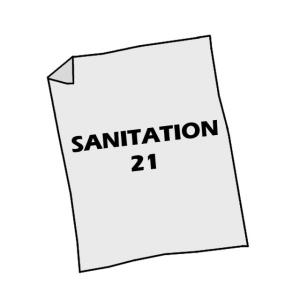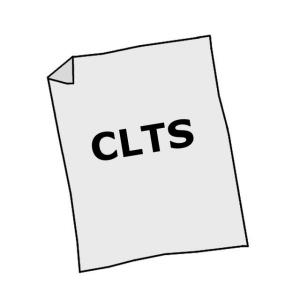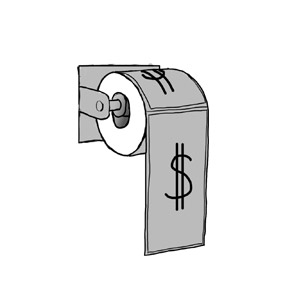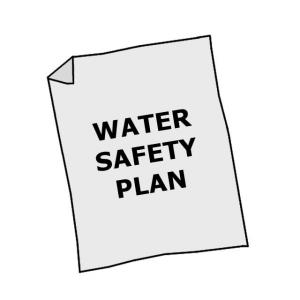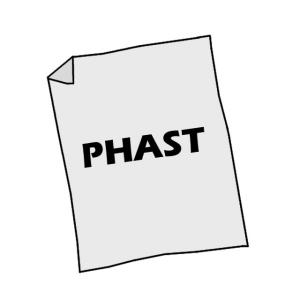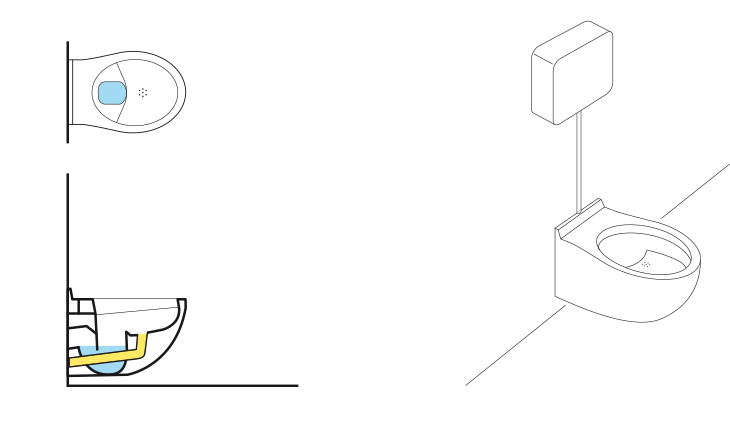
Executive Summary
The urine-diverting flush toilet (UDFT) is similar in appearance to a cistern flush toilet except for the diversion in the bowl. The toilet bowl has two sections so that the urine can be separated from the faeces. Both sitting and squatting models exist.
| In | Out |
|---|---|
| Freshwater, Urine, Faeces, Dry Cleansing Material, Anal Cleansing Water |
Brownwater, Urine, Yellowwater |
Introduction
The urine diversion flush toilet is similar in appearance to a cistern flush toilet except for the diversion in the bowl. The toilet bowl has two sections so that the urine can be separated from the faeces.
Urine is collected in a drain in the front of the toilet and faeces are collected in the back. The urine is collected without water, but a small amount of water is used to rinse the urine-collection bowl when the toilet is flushed. The urine flows into a storage tank for further use (use of urine at small or large-scale)or processing (storage, desiccation, struvite production), while the faeces are flushed with water to be treated (onsite pre-treatment and treatment in septic tanks, biogas settlers, anaerobic baffled reactors; semi-decentralised treatment units, e.g. DEWATS systems; centralised sewage treatment plants).
Design considerations
The system requires dual plumbing, i.e., separate piping for urine and brownwater (faeces, dry cleansing material and flushing water).
The toilet should be installed carefully with an understanding of how and where clogs may occur so that they can be prevented and easily removed. For the discharge of urine, plastic pipes should be used to prevent corrosion. To limit scaling, all connections (pipes) to storage tanks (see urine storage tank) should be kept as short as possible; whenever they exist, pipes should be installed with at least a 1% slope, and sharp angles (90°) should be avoided. A pipe diameter of 50 mm is sufficient for steep slopes and where maintenance is easy. Larger diameter pipes (> 75 mm) should be used elsewhere, especially for minimum slopes, and where access is difficult.
Health aspects/acceptance
Information cards and/or diagrams are essential for ensuring proper use and for promoting acceptance. If users understand why the urine is being separated they will be more willing to use the toilet properly. Proper plumbing will ensure that there are no odours.
Operation & maintenance
As with any toilet, proper cleaning is important to keep the bowl(s) clean and prevent stains from forming. Because urine is collected separately, calcium- and magnesium-based minerals and salts can precipitate and build up in the fittings and pipes. Washing the bowl with a mild acid (e.g., vinegar) and/or hot water can prevent the build-up of mineral deposits and scaling. Stronger (> 24% acetic) acid or a caustic soda solution (2 parts water to 1 part soda) can be used for removing blockages. However, in some cases manual removal may be required.
A UDFT is adequate when there is enough water for flushing, a treatment technology for the brownwater and a use for the collected urine. To improve diversion efficiency, urinals for men are recommended (U.3) (see also urinals).
UDFTs are suitable for public and private applications, although significant training and awareness is required in public settings to ensure proper use and minimize clogging.
Since this technology requires separate pipes for urine and brownwater collection, the plumbing is more complicated than for cistern flush toilets. Particularly, the proper design and installation of the urine pipes is crucial, and requires expertise.
As urine diversion flush toilets have been designed for users in high-income countries, they have been manufactured only in ceramic and have a similar appearance to conventional flush toilets (MUENCH et al. 2009).
The toilet should be installed carefully with an understanding of how and where clogs may occur so that they can be easily removed.
Urine Diversion - One Step Towards Sustainable Sanitation
This report of Stockholm environment institute (SEI) presents the current state-of-the-art (2006) of urine-diverting systems, focusing on the Swedish experience and what can be learned from that experience. The intention is to inspire decision- and policy-makers to consider urine diversion for sanitation interventions aimed at meeting the sanitation target of the Millennium Development Goals.
KVARNSTROEM, E. EMILSSON, K. RICHERT STINTZING A. JOHANSSON, M. JOENSSON, H. PETERSENS, E. SCHOENNING, C. CHRISTENSEN, J. HELLSTROEM, D. QVARNSTROEM, L. RIDDERSTOLPE, P. DRANGERT, J.O. (2006): Urine Diversion - One Step Towards Sustainable Sanitation. (= EcoSanRes Publication Series ). Stockholm: Stockholm Environment Institute (SEI) URL [Accessed: 27.07.2010]Novaquatis final report. NoMix – A new approach to urban water management
From 2000 to 2006, the cross-cutting project Novaquatis explored the potential of urine source separation – also known as NoMix technology. Novaquatis comprises nine work packages, largely organized around the various stages of a nutrient cycle (e.g. user acceptation, sanitary technologies, storage and transport, urine treatment and fertiliser production, micropollutants in urine, urine-based fertilisers). The final report contains the results of all working packages as well as a practical guide for interested NoMix user.
LARSEN, T. A. LIENERT, J. (2007): Novaquatis final report. NoMix – A new approach to urban water management. Duebendorf: Swiss Federal Institute for Environmental Science (EAWAG) URL [Accessed: 12.05.2019]Technology Review of Urine Diversion Components
The publication explains the purposes of urine diversion, its benefits and challenges, urine precipitation, urine treatment and reuse in agriculture. Further, it provides an overview on design and operational aspects for equipment needed, such as waterless urinals and urine diversion toilets including supplier information and indicative costs. Overall, it pulls together scattered knowledge around the topic of urine diversion in a concise manner.
MUENCH, E. von WINKER, M. (2011): Technology Review of Urine Diversion Components. Overview of Urine Diversion Components such as Waterless Urinals, Urine Diversion Toilets, Urine Storage and Reuse Systems. Eschborn: Deutsche Gesellschaft für Internationale Zusammenarbeit (GIZ) GmbH URL [Accessed: 11.05.2019]Urine and brownwater separation at the GTZ main office building, Eschborn, Germany
This case study is about a demonstration project in the headquarters of GTZ in Eschborn, Germany. The project consists of 50 urine-diversion flush toilets, 23 waterless urinals and 10 m³ urine storage tank.
WINKER, M. SADOUN, A. (2011): Urine and brownwater separation at the GTZ main office building, Eschborn, Germany. (= SuSanA - Case Studies ). Eschborn: Sustainable Sanitation Alliance (SuSanA) URL [Accessed: 12.05.2019]
